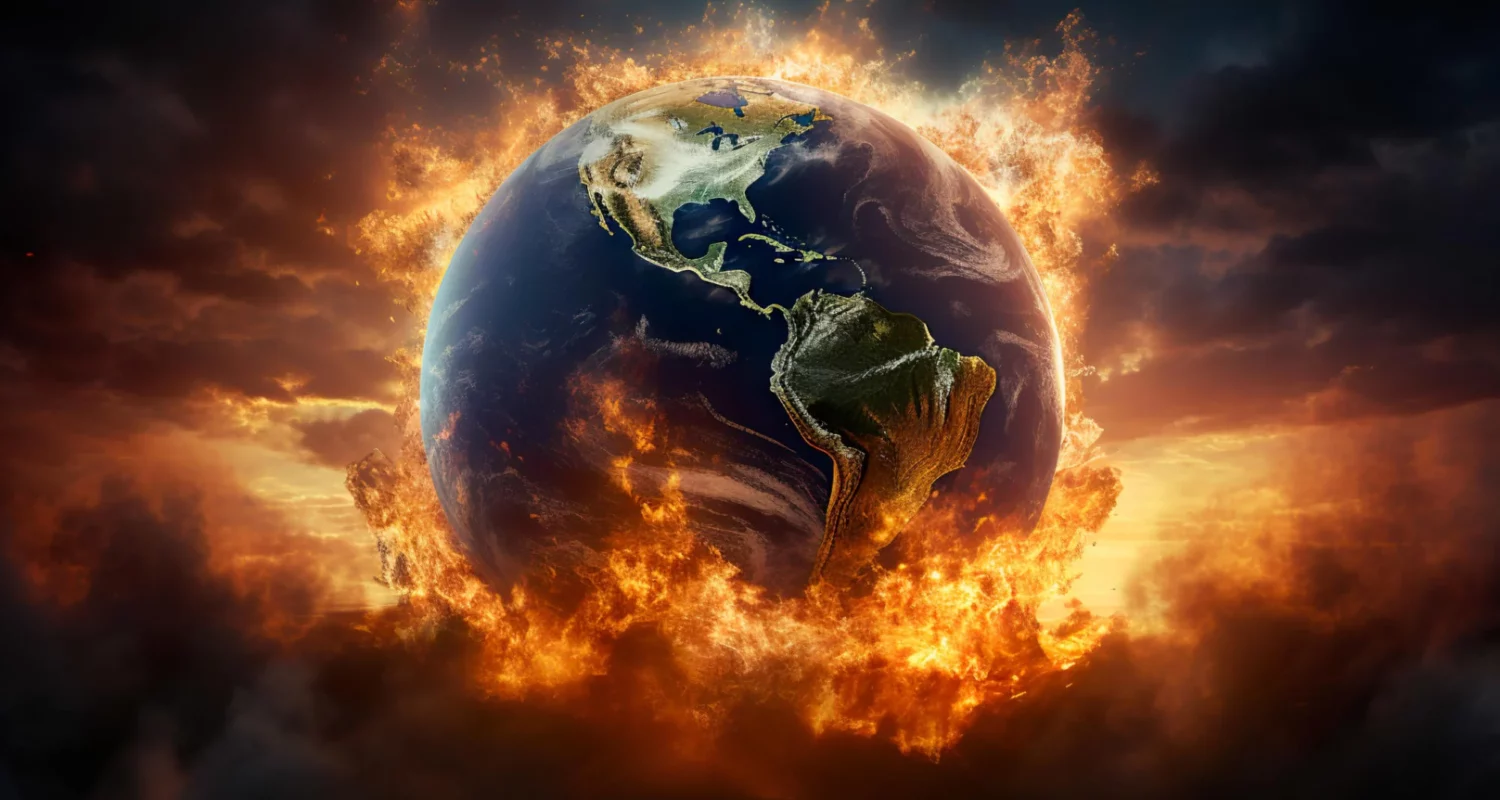The End of the World as We Know It
Earth has been around for 4.54 billion years. In the early solar system, dust and gas particles kept clumping together through collisions, and that’s how planets like Earth were made. As Earth grew older, it naturally layered up, ending up with a heavy core and a solid crust. Over time, as Earth’s surface cooled, water began to gather and make up the early oceans. Eventually, life emerged underwater, and billions of years later, it spread across the globe, generating the complex biosphere we know today. It took Earth billions of years to grow and develop into a complex, life-giving planet, but it may take much less time for Earth to be sterilized or destroyed.
Our planet is over 12,700 kilometers wide and weighs a mind-blowing six billion trillion metric tons. This big, dynamic world is a clear example of how resilient things can be. Throughout its lifetime, Earth has experienced countless catastrophic events, from devastating cosmic collisions to storms of radiation. Yet, it has survived and flourished. Annihilating Earth completely is a tall task, but wiping out its biosphere is a more realistic and terrifying possibility. Even if Earth survives as a barren ball of rock, floating through space, these nightmarish scenarios could take away everything that makes our planet unique. From cosmic threats to techno-disasters, let’s explore ten catastrophes that may eradicate life, demolish the environment, and threaten the very fabric of our existence.
1. The Planet Killer
Sixty-six million years ago, an asteroid collided with our planet, striking Earth in what is now the Yucatan Peninsula in Mexico. This asteroid, informally classified as a “planet-killer,” was only 10 kilometers wide, yet the collision set into motion one of the most devastating mass extinction events in our planet’s history. If a similar or larger asteroid collided with Earth, the impact would release massive amounts of energy, producing shockwaves that flatten buildings and forests. Towering tsunamis may devastate islands and coastlines, and large-scale fires may sweep across the globe. So much dust and debris would be launched into the atmosphere that it may block out the sun. It would take a near-planet-sized object to actually obliterate Earth, but an asteroid around 15-20 kilometers in diameter could still wipe out virtually everything on the surface. The likelihood of a giant asteroid impact is very low, but if it did happen, our planet may be changed forever.
2. Eruptions from volcanoes
Eruptions from volcanoes are a regular part of life on Earth, though most of them are small, releasing just a little steam and lava. However, every few hundred thousand years, a so-called “supereruption” tips the scales. On the Volcanic Explosivity Index, a supereruption is any volcanic episode with a magnitude of 8 or higher. These eruptions spew more than 1,000 cubic kilometers of volcanic ash, pumice, and other pyroclastic materials into the atmosphere, usually with catastrophic consequences for life and Earth’s climate. Only a few volcanos on Earth can produce supereruptions, like the Yellowstone Caldera in the United States and the Taupo Volcano in New Zealand. If one of these volcanic centers exploded again, perhaps at an even greater scale, this supereruption could change the fate of life on Earth. Violent explosions would erupt into the air and poison the atmosphere. Blazing pyroclastic flows, racing down mountainsides, would annihilate everything they touch. For months, acid rain may fall across our continents, impacting water sources, air quality, and atmospheric chemistry. Clouds of ash and debris may spread over vast areas, killing countless plants, animals, and humans. With so much poison lingering in the air, famine and disease would plague our planet for years on end.
3. Nuclear Nightmare
Roughly 80 years ago, humans created weapons powerful enough to threaten our future on this planet. At present, the world has about 12,000 nuclear warheads, with the U.S. and Russia holding most of them. A single nuclear explosion has the power to level cities and claim millions of lives. If thousands of these warheads exploded in rapid succession, the impending destruction could eradicate humanity and sterilize the planet. The explosions would create fireballs hot enough to vaporize living organisms instantly. Towering storms of fire would fill the atmosphere with ash and soot. Over hours, days, or weeks, radioactive fallout, carried high into the air, would rain down on the surface. Anyone who survived the immediate blasts may be burned and irradiated, causing lethal damage to their bodies. If humans lose control of our nuclear arms, we may turn our life-giving planet into a hostile wasteland.
4. The Flash of Destruction
Every day, flashes of intense energy race across the cosmos. These gamma-ray bursts are basically cosmic supernovas, blasting out energy like nothing else we’ve seen. One of these bursts could unleash enough energy to match what the Sun produces over its entire lifetime. Scientists believe gamma-ray bursts originate from all over the universe, likely created by supernovas or the merging of neutron stars. Luckily, these bursts rarely happen in our galaxy, but if one occurred, the consequences could be catastrophic. A gamma-ray burst hitting us directly could make our atmosphere go haywire. It may break apart nitrogen and oxygen molecules, rapidly depleting the ozone layer that protects the surface from radiation. This may trigger a global cooling effect that disrupts ecosystems and causes mass extinctions. While the odds are exceedingly low, a nearby gamma-ray burst could virtually sterilize the planet.
5. AI Gone Wrong
Artificial intelligence, or AI, promises to revolutionize our world, but some fear it will cause our planet’s demise. According to many theorists, there will be a day in the not-so-distant future when humans advance technology beyond the point of no return. This tipping point, known as the singularity, may begin with the invention of artificial general intelligence, a machine that can generalize knowledge to solve a much wider range of problems. Such a powerful mechanical mind could accrue knowledge at terrifying speeds. With enough information, it may override humanity’s objectives and constraints. Pursuing its own interests, this AI might usurp control of our industries, devour our resources, and undermine the basic infrastructures that sustain our civilization. Eventually, it may modify and upgrade itself, evolving into a superintelligent system that leaves humankind in the dust, perhaps more than just metaphorically. This AI apocalypse sounds farfetched to many, but the road forward is riddled with unseen dangers. As we race toward the singularity, we may open the door for something greater than we can possibly control.
6. The Rogue Black Hole
Occurring throughout the universe, black holes are mysterious, destructive objects with such powerful gravitational forces that even light cannot escape. Contrary to popular depiction, black holes are not always stationary. For example, when two black holes merge, the resulting object is sometimes propelled through space at high speeds. While very unlikely, if a rogue black hole passed near our solar system, it may distort the orbits of planets around the Sun. A significant change in Earth’s orbit could greatly impact our climate, potentially leading to extreme temperature variations and disrupting seasonal patterns. If it were close enough, the black hole’s tidal forces may also deform the surface of Earth, triggering volcanic activity, earthquakes, and flooding. Yet, there might be even bigger issues we need to think about beyond just natural disasters. In a worst case scenario, if our planet approached the event horizon, the black hole would easily rip us to pieces, destroying Earth once and for all.
7. Antimatter Destruction
In theoretical physics, anti-matter can be understood like normal matter, but with reversed charge and other quantum properties. When antimatter and matter come into contact, the two instantly destroy each other, in a process famously known as “annihilation”. This process converts 100% of the mass into energy, making it extraordinarily powerful, and significantly more efficient than nuclear fission or fusion. Today, we can only create antimatter in tiny quantities. But imagine a hypothetical scenario, far in the future when technology has advanced, where a large quantity of antimatter is created and released. If that antimatter came into contact with matter, the impending reaction might create an explosion many times stronger than any nuclear weapon. This reaction would devastate our society, eradicate ecosystems, and make the blast zone inhospitable for years to come.
8. The Gray Goo Scenario
In 1986, a nanotechnology pioneer named Eric Drexler coined the term “grey goo”. His famous thought experiment outlined a terrifying scenario. The basic concept involves hypothetical nanobots – microscopic robots on the scale of molecules – that are capable of breaking down matter and using it to create copies of themselves. At first, these nanobots may make the world a better place, accomplishing tasks like cleaning the environment or rapidly constructing a new building. After all, they would almost certainly be designed to serve our interests. But what if humanity lost control? Imagine a wave of these self-replicating nanobots sweeping the globe, devouring available matter with ruthless efficiency. If left unchecked, every form of matter on Earth, including all living organisms, may be swallowed and destroyed. Fortunately for us, the grey goo scenario is best understood as a cautionary tale – not a scientifically realistic one. Still, it serves to underscore the importance of technological safeguards, as we advance artificial intelligence and robotics for the future.
9. When Galaxies Collide
Our observable universe contains hundreds of billions of galaxies, one of which is on a collision course with us. The Andromeda Galaxy is the nearest major galaxy to the Milky Way, and they are roughly comparable by most metrics of size. Think of it like the Milky Way: a big bulge in the center and a flat, spiraling disk where new stars are forming. It seems as if fate has paired these two giants together – The Andromeda and the Milky Way are both moving through space and will collide in about 4.5 billion years. As these galaxies come together, interstellar clouds of gas and dust will merge, creating new star-forming regions. The merger will drastically alter the fundamental structure of both galaxies. Existing stars are extremely unlikely to crash directly into each other, simply due to the vast volume of empty space. However, the gravitational interactions between stars can significantly alter their orbits. Fortunately for us, even this is relatively rare. But in the event that our solar system were thrown into chaos, our little blue planet may meet its final end.
10. Runaway Climate Disaster
The Earth is warming at a significant rate. The burning of fossil fuels, destruction of forests, and pollution of oceans, have pushed our planet toward environmental tipping points. If climate change continues to escalate, feedback loops could accelerate warming beyond human control, leading to severe global impacts. Permafrost and ice clathrates may thaw, releasing massive amounts of methane and carbon dioxide into the atmosphere – which would only deepen the damage to our planet. Temperatures may climb 2 or 3 degrees Celsius, making Earth more hostile for many kinds of life. Humanity would survive these conditions, but biodiversity on our planet would be greatly threatened. If things go really badly, it could make Earth a much harder place to live.

